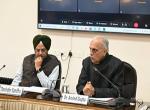On July 23, the Vivekananda International Foundation (VIF) organized a talk on ‘‘Relationship between Hinduism and Buddhism” by Prof. Arvind Sharma, Birks Professor of Comparative Religion in the School of Religious Studies at McGill University in Montreal, Canada, and formerly part of the Indian Administrative Service (IAS). This was the fourth talk in the series of lectures and discussions on Indic religious traditions.
Dr. Arvind Gupta, Director, VIF, delivered the opening remarks, in which he briefly talked about the Samvad, the Global Hindu-Buddhist Initiative started by VIF in 2015. It was a joint initiative between PM Narendra Modi and former Japanese Prime Minister Shinzo Abe. The Hindu and Buddhist philosophies, which have a common origin and retained their mutual and symbiotic relations, also believe in dialogue as the normal way to create and sustain human consciousness and avoid conflicts. The VIF has conducted multiple meetings of the Global Hindu Buddhist Initiative with Hindu and Buddhist scholars from India and Buddhist countries. The key theme in these meetings has been avoidance of conflict and environmental consciousness. Dr. Arvind Gupta also talked about how Buddhism spread from India into China, Japan, the Korean Peninsula, and Southeast Asia. He highlighted that India is not doing enough to leverage Buddhism as a part of India’s foreign policy. On the other hand, the atheist communist state of China is owing Buddhism. The Chinese are spending huge resources on promoting Chinese ownership of Buddhism.
In his keynote address, Prof. Arvind Sharma talked about the arrival of Dalai Lama from Tibet to India in 1959. The then Prime Minister of India, Jawaharlal Nehru, announced in the Indian Parliament that the Dalai Lama had set foot on the Indian soil. The Indian Parliament burst into spontaneous applause. The question here was, what had made a parliament with predominantly Hindu representatives erupt in spontaneous applause for the arrival of a Buddhist spiritual leader? One raises this question because in the study of comparative religion, it is taught that Hinduism and Buddhism are two different religions. It is also propagated that Hinduism was responsible for the disappearance of Buddhism in India.
The first perspective in this regard says Buddhism arose as a protest against Hinduism’s metaphysical and sociopolitical orientation. Buddhism was gaining ground in India, and it tried to displace Hinduism. But subsequently, the tide turned in favour of Hinduism, and it started absorbing Buddhism into itself. The second perspective retains the oppositional framework between Hinduism and Buddhism but attributes the disappearance of Buddhism in India as a failure of the religion. The rich stream of cultural life inspired by the Buddha progressed during the centuries following his Mahaparinirvan, gradually acquiring a varied and individual aspect, whatever remaining tributary to that larger stream of Indian culture into which it ultimately merged. One could view the interactions between Hinduism and Buddhism as an interaction between two strands, or the Indic religious traditions.
Prof. Sharma asserted that the 6th or 7th centuries CE saw the acceptance of Buddha as an incarnation of Lord Vishnu. This point is used by a sect of scholars to highlight the hospitality of the two religious traditions towards each other. The reception of Buddha among the avatars of Vishnu expresses a spirit of tolerance. But there is a section of scholars who believe that inclusion of Buddha as an avatar of Vishnu depicts the hostility between Hinduism and Buddhism. They point out that according to the Vishnu Puran, the Buddha appeared in the world to lead people away from the Vedic path. Buddha was included in the list of Vishnu Avatars in order to assimilate the heterodox elements into Vaishnavism.
Prof. Sharma explained that the similarity of the two religious traditions in their attitudes towards the scriptural authority is hard to miss. A hymn from the Upanishads states that “There the sun cannot shine and the moon has no lustre; all the stars are blind; there our lightning flashes not, nor any earthly fire. For all that is bright is but the shadow of His brightness, and by His shining all this shines.” In Buddhism, we find a similar passage in the Udana text: “Where earth, water, fire and air do not penetrate, the stars do not glitter, or the sun gives its light, the moon too does not shine there, but there is not darkness” Prof. Sharma ended his talk with a statement given by the holy Dalai Lama in November 1992: “When I say that Buddhism is a part of Hinduism, certain people criticize me. But if I were to say that Hinduism and Buddhism are totally different, it would not be in conformity with the truth.”
In agreement with Prof. Arvind Sharma, Prof. Ram Nath Jha from the School of Sanskrit and Indic Studies, Jawaharlal Nehru University, stated that the texts like Tarikh Al Hind by Al Biruni, along with other texts of the time, accept all knowledge systems prevailing in India as Hindu traditions; this includes Buddhist and Jaina traditions. The western scholar later suggested that they were aware of the differences between the various knowledge traditions present in India, but still these traditions were very akin to each other. All the Indian traditions, like Hinduism, Buddhism and Jainism, are similar because they believe in arguments and dialogue. Their differences between each other are sorted out with the help of dialogue. This practice of peaceful resolution of conflict is not available in Semitic religions. Prof. Ram Nath Jha also highlighted the issues with the addition of the suffix “Ism” to Indic religious traditions in India, like Hinduism, Buddhism, Jainism and Sikhism. The Cambridge dictionary describes ‘ism’ as “a set of beliefs, especially ones that you disapprove of.” Therefore, Indic religious traditions should not be associated with the aforementioned suffix. The session was then opened for discussion, followed by closing remarks by Dr. Arvind Gupta.










Post new comment